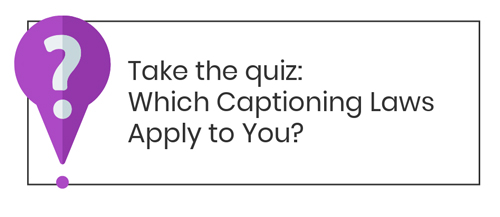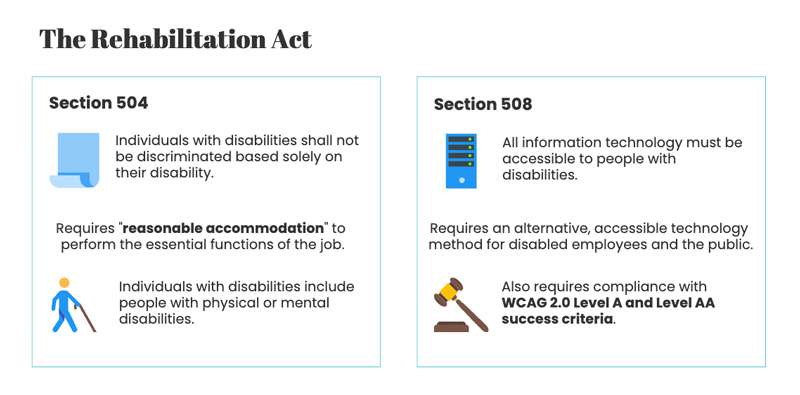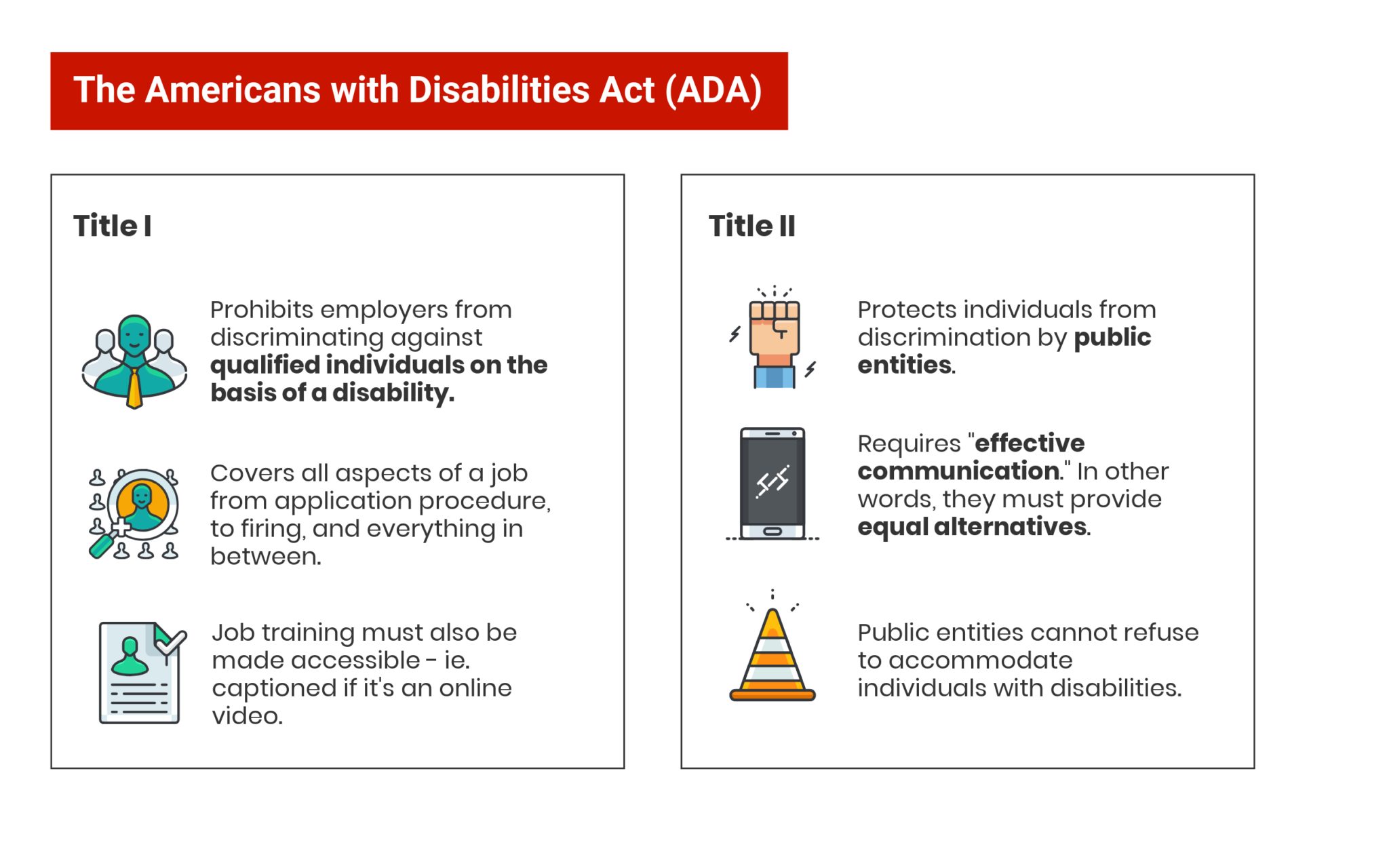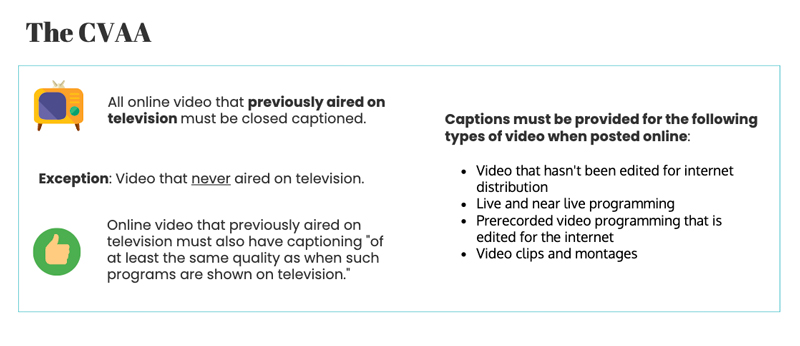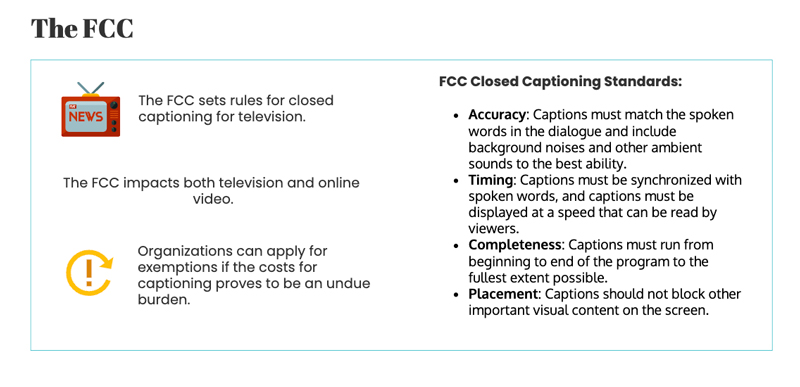How to Tell If You Are Required to Caption Your Videos
Updated: August 7, 2024
Captioning is a critical part of video accessibility. But not all organizations are required to caption (though they should still caption!).
Captioning requirements also vary by industry, and often, complying with one law doesn’t mean you comply with all the laws.
Because of all the requirements, understanding which laws you need to comply with can be a bit confusing and ambiguous.
But, fear not! Here is an easy guide to knowing if you need to caption your videos.
Do you create video?
Since captioning laws vary by industry, it’s important to understand where you fit in.
Typically, you will be required to caption if you fit into the following categories:
- You are any type of government program
- Your state has accessibility laws requiring captioning
- You provide a service to the public
- You are a public entity
- You provide educational materials
- You publish video that appears on TV
- You produce video for TV
Complying with more than one accessibility law
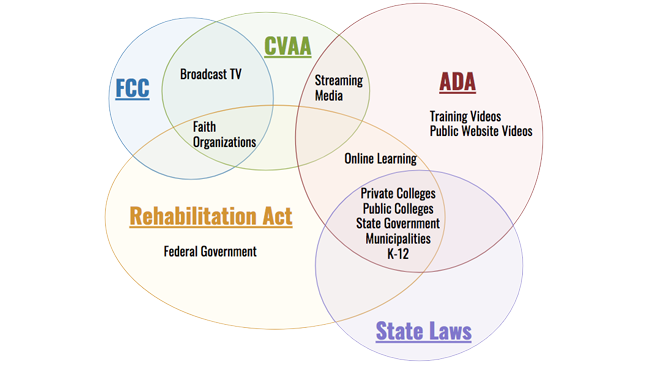
When it comes to video accessibility, complying with one law doesn’t mean you comply with all the laws.
The classic example of this is the case between Netflix and the National Association of the Deaf. Netflix, a streaming site, must comply with the CVAA and the ADA.
While Netflix captioned all content that previously appeared on television – therefore complying with the CVAA – they failed to caption a lot of their other “Watch Instantly” content. Netflix argued that their original content never appeared on television and therefore didn’t need to be captioned.
But the courts ruled that under Title III of the ADA, Netflix was considered a place of public accommodation, and therefore they needed to comply with the ADA and caption all their content.
The above venn diagram illustrates how different industries overlap several accessibility laws.
The easiest way to understand which accessibility laws apply to you is by locating where you fit in the accessibility law venn diagram, then making sure you meet each law’s requirements.
The Five Major Video Accessibility Laws
There are five video accessibility laws in the United States that dictate whether you need to caption or not.
The five major video accessibility laws are:
- The Rehabilitation Act
- The Americans with Disabilities Act (ADA)
- The 21st Century Communications and Video Accessibility Act (CVAA)
- The Federal Communications Commission (FCC)
- State laws
The Rehabilitation Act
Applies to:
- Federal Government
- Online Learning
- Private Colleges
- Public Colleges
- State Government
- Municipalities
- Faith Organizations
- K-12
The Rehabilitation Act is a federal anti-discrimination law.
Under the Rehabilitation Act, Section 504 and Section 508 apply to online accessibility. Not all organizations are required to adhere to both Sections.
Sections 504 applies to federal and federally funded programs like colleges, airports, police stations. Section 508 applies to the federal government only, except when a state has enacted a “mini 508” or a federal grant requires compliance with Section 508 – like the Assistive Technology Act.
If a faith organization receives government financial aid, then they must comply with Section 504 of the Rehabilitation Act.
Most educational institutions receive federal funding, and therefore must comply with Section 504 and Section 508. Section 504 applies to “local educational agencies, systems of vocational education, and other school systems.”
The Americans with Disabilities Act (ADA)
Applies to:
- Training Videos
- Public Website Videos
- Streaming Media
- Online Learning
- Private Colleges
- Public Colleges
- State Government
- Municipalities
- K-12
The Americans with Disabilities Act (ADA) was created to ensure equal opportunity for people with disabilities.
Title II and Title III of the ADA relate to web accessibility for state, local, public and private entities.
The ADA was intended to apply to physical structures, but through legal action, it has been extended to online content.
Local government, state government, private colleges and public colleges are directly referenced in Title II of the ADA.
Title II of the ADA has also been applied to private entities. Under the Title, employee training videos must also comply with the ADA. In 2015, FedEx was sued for failing to caption their online training videos.
Title III of the ADA relates to private entities like private businesses and private colleges.
Organizations like Netflix, Hulu, Amazon, MIT, and Harvard have all been sued for failing to caption their content.
In the MIT and Harvard lawsuit, caption quality was also addressed; the schools were sued for having “unintelligible” captioning, which does not create an equal experience.
In addition, public websites and their videos must be accessible. Both Winn-Dixie and Target have been sued for having inaccessible websites.
The CVAA
Applies to:
- Broadcast TV
- Faith Organizations
- Streaming Media
The 21st Century Communications and Video Accessibility Act (CVAA) states that all online video previously aired on television is required to have closed captioning (including clips and montages).
If your video content has never aired on television (like a vlog on YouTube), this act does not apply to you.
Video creators and content distributors are responsible for ensuring their content is properly captioned.
Streaming sites like Netflix, Hulu, and Amazon, must caption all content that was previously aired on television. Note: under the ADA, they must also caption original content, even if it never appeared on television (like Netflix’s Stranger Things).
Faith organizations that broadcast their sermons must also caption them when posted online.
The FCC
Applies to:
- Broadcast TV
- Faith Organizations
The Federal Communications Commision (FCC) requires broadcasts content to be captioned.
Any content broadcast on television must provide closed captioning for live and recorded content. As of 2011, religious organizations that broadcast on television are no longer exempt from the FCC’s requirements for captioning; now, any faith organizations publishing content on television must caption under the FCC.
Broadcast organizations must also be aware of the audio description requirements under the CVAA.
State Laws
Applies to:
- Private Colleges
- Public Colleges
- State Government
- Municipalities
- K-12
Many states have enacted their own accessibility laws. Several states have even created “mini 508s” which require institutions to comply with Section 508 of the Rehabilitation Act.
Educational institutions, state governments, and local governments should all be mindful of their state accessibility laws.
In addition, these institutions must be mindful of other accessibility laws that apply to them. Private and public colleges, state governments, municipalities, and K-12 must also adhere to the Rehabilitation Act and the ADA.
The benefits of captioning
When your videos aren’t accessible, you are alienating a big portion of the population. In America alone, there are 48 million people who are d/Deaf and hard of hearing.
But beyond the accessibility benefits, captioning your videos also benefits individuals without disabilities. Captions allow people to access your videos in loud or quiet environments, like at the gym or at a library.
Furthermore, industry trends show people prefer their videos on silent. Facebook found that 80% of users reacted negatively to videos played with the sound on. That’s why they decided to autoplay videos without sound.
Adding captions lets the user make sense of your video without the need of sound.
In the academic realm, many students turn transcripts into study guides.
Captioning your videos also improves SEO. Since bots can’t read the content of your video, adding captions and transcripts gives bots a text version of your video so that they can properly index it.
If you want to enhance the user experience, improve brand recall, increase SEO, and avoid costly litigations, consider captioning your videos. You won’t regret it!
This blog post is written for educational and general information purposes only, and does not constitute specific legal advice. This blog should not be used as a substitute for competent legal advice from a licensed professional attorney in your state.



